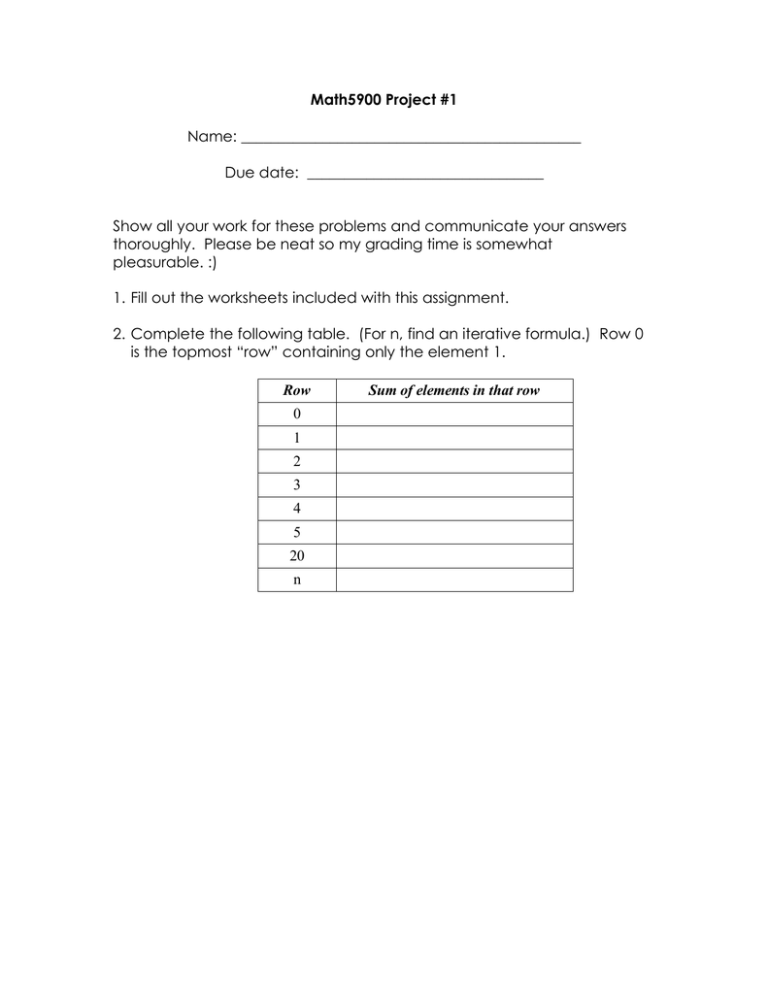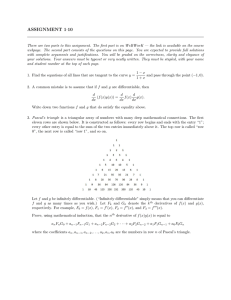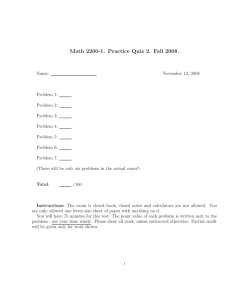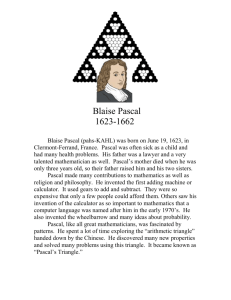Math5900 Project #1 ______________________________________________ Due date: ________________________________
advertisement

Math5900 Project #1 Name: ______________________________________________ Due date: ________________________________ Show all your work for these problems and communicate your answers thoroughly. Please be neat so my grading time is somewhat pleasurable. :) 1. Fill out the worksheets included with this assignment. 2. Complete the following table. (For n, find an iterative formula.) Row 0 is the topmost “row” containing only the element 1. Row 0 1 2 3 4 5 20 n Sum of elements in that row 3. (a) Look at the topmost left-to-right diagonal (that doesn't contain all ones) in Pascal's Triangle, and fill in this table while referring to that diagonal. Row Sum of diagonal elements Location of that sum (as an element) in Pascal's Triangle 1 2 3 4 5 n (b) Look at the next left-to-right diagonal (below the one we just considered) and complete the table while referring to that diagonal. Row 1 2 3 4 5 n Sum of diagonal elements Location of that sum (as an element) in Pascal's Triangle (c) Based on the results from #3(a) and #3(b) what is the pattern that will give the sum of any number of elements in any diagonal? 4. Complete the table. Row 0 1 2 3 4 n Sum of ALL elements in Pascal's Triangle (up to and including the specified row) 5. Use the grid below. (a) Start at point A and only go right or up. How many routes are there from: (1) A to B? ______________ (2) A to C? ______________ (3) A to D? ______________ (4) A to E? ______________ (5) A to F? ______________ (6) A to G? (7) A to H? (8) A to I? ______________ ______________ ______________ (b) Write the number of routes from A to another letter next to that letter on the grid. Do you see a familiar pattern? How is Pascal's Triangle involved? (c) How many different routes are there from A to Y only moving right or up? 6. (a) We have looked at triangular numbers in class. Here's an illustration of the first four triangular numbers along with a table. Finish filling in the table. o n=1 o o o o o o o o o o n=4 o o o o n=2 o o o o o n=3 n (which triangular number) # dots in the triangular number 1 1 2 3 3 4 5 6 n (b) Square numbers can be arranged in a square array, as illustrated. Fill in the table for square numbers. o n=1 o o o o o o o n=2 n (which square number) 1 2 3 4 5 6 n o o o o o o n=3 o o o o # dots in the square number o o o o o o o o n=4 o o o o (c) Pentagonal numbers can be arranged in a pentagonal array, as illustrated. Fill in the table for pentagonal numbers. o o o o o o o o o o o o o o o o o o o o o o o o o o o o o o o o o o o o o o o o n=1 n=2 n=3 n=4 n (which pentagonal number) # dots in the pentagonal number 1 2 3 4 5 6 n (d)What is the relationship (given by a mathematical formula) between the triangular numbers and the square numbers? (e) What is the relationship (given by a mathematical formula) between the triangular numbers and the pentagonal numbers? 7. (a) The square numbers (from 6(b)) can be found in at least two patterns in Pascal's Triangle. What are these patterns? (Hint: The patterns involve the sum of certain numbers in the triangle.) (b) Can you find a pattern for pentagonal numbers? If so, what is it? 8. (a) The following sequence is called the Fibonacci sequence. Find the pattern and fill in the next five elements of the sequence. 1, 1, 2, 3, 5, 8, ______, ______, ______, ______, ______, . . . Describe the pattern in words: (b) These elements can be found in Pascal's Triangle. The pattern contains sets of numbers that when summed equal the elements of the Fibonacci sequence. What is the pattern? (Note: The pattern will reveal the sequence in order.) 9. The six numbers that form a “circle” around another number in Pascal's Triangle are called a ring. The product of the six numbers in a ring has a special property. (a) What is that property? (b) Give some examples.



